Meet iii-resident Jesus Canuto Iglesias
Jesus Canuto Iglesias is the first resident at iii workspace for the No Patent Pending program of 2020. With the restrictions during the coronacrisis in mind, we still decided to meet in person in his studio at De Besturing, a studiocomplex in the industrial area of The Hague. We sit around his new sculptural work which has the safe one-and-a-half meter dimensions and discuss the ideas and plans of the Madrid born artist.
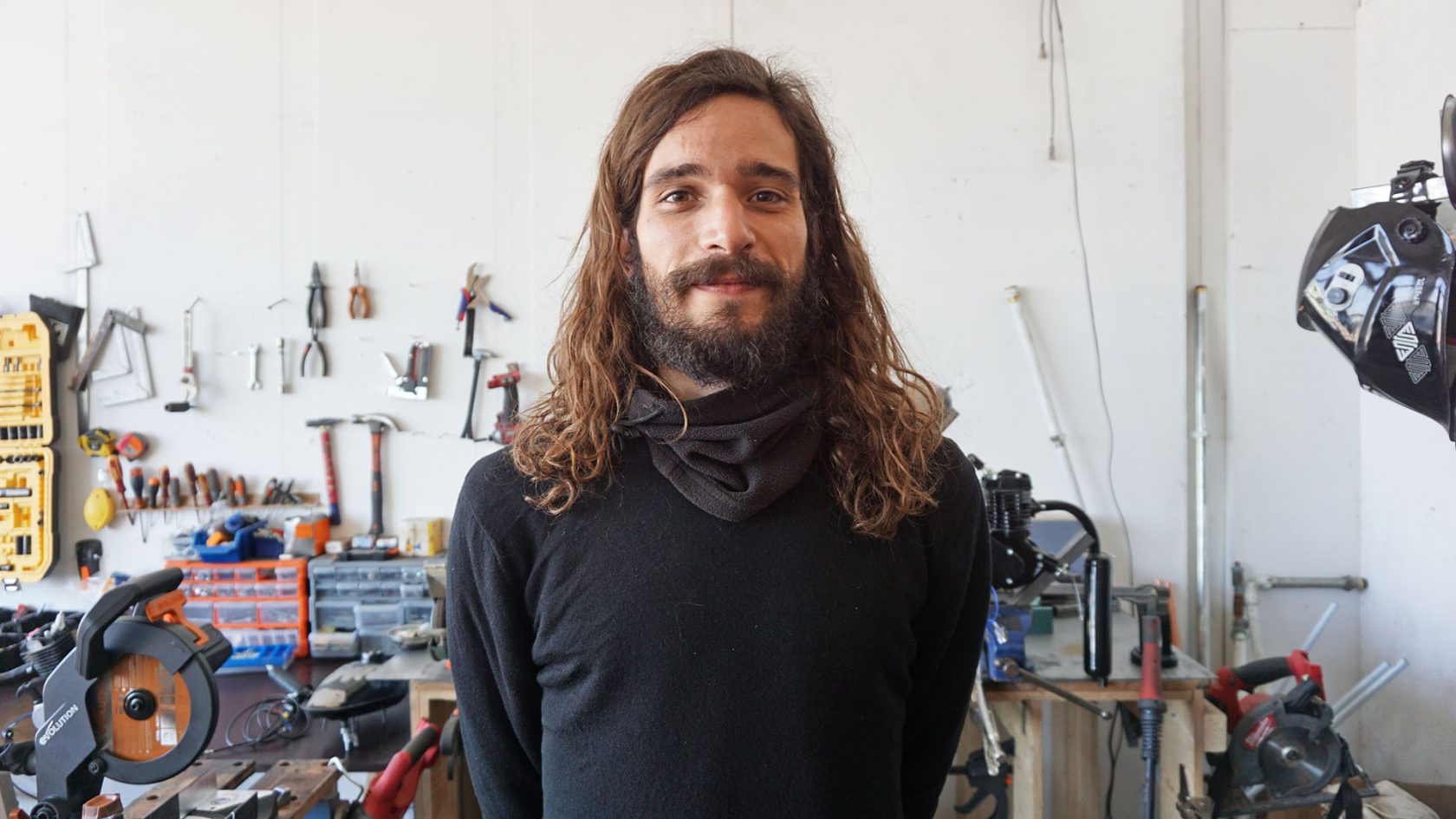
Frits Dijcks: You are working on an instrument that is made out of an old moped and a damaged tuba. Where does this idea come from?
Jesus Canuto Iglesias: Yes. It is called ‘The last song of a two stroke engine’. It is based on the upcoming ban on two stroke engines in The Hague and the disappearance of the sound of mopeds in the streets. I am personally interested in human biases on these kind of developments. It is a bit like: What was a horse thinking when the first cars were introduced? There is a similar situation right now with these mopeds. I know these motors and especially the Puch brand was a cultural phenomenon in this town. I want to emphasize the characteristic sound of these kind of motors.
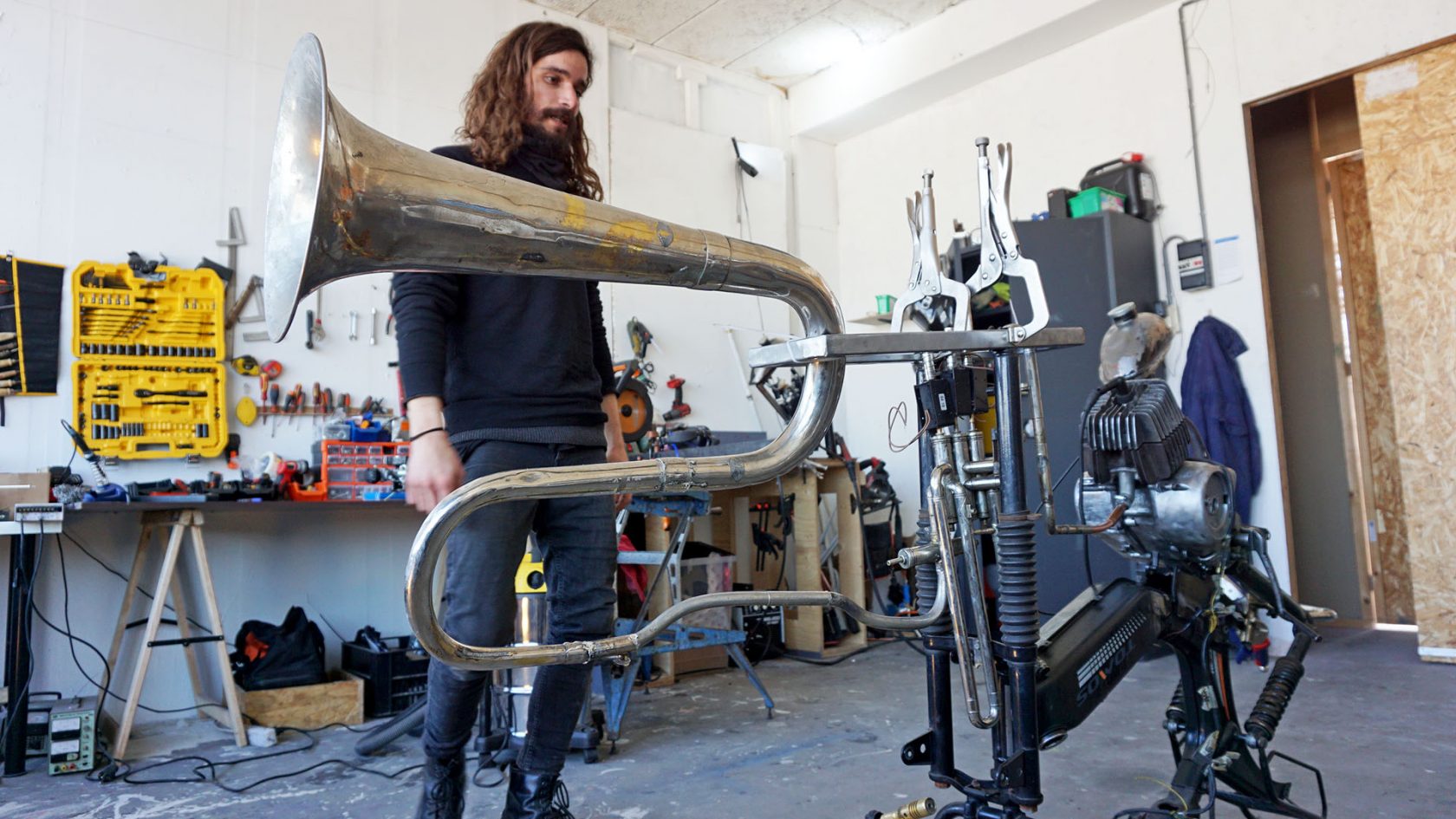
You have turned the beast upside down with its legs up in the air?
I wanted to make a simple image. I removed the wheels because I don’t need them. I don’t want to use its function and focus on the sound of it. I am going to automate the installation. A computer will activate the valves and play the tuba using the thousands of little explosions inside the engine. Also the throttle will be controlled by a motor. I want the work to be automated, not composed.
To execute my ideas, I work with YouTube as a learning tool. I watch hours and hours of online movies to find the solutions to the problems I come across. It is now part of my studio practice in isolation. I knew almost nothing before starting this project. In two months I had to learn the operation of a two stroke engine and how to tune it. It is a super good resource. Sometimes I recognize the same with other artists who use certain techniques. Than I can even tell them which online video they must have seen.
I also used these sources on how to handle brass instruments. It’s a niche market. So I watched how instrument makers work. They have years and years of experience that I can use. I also wanted to polish the instrument, which is something I learned from earlier projects.
So to let the motor breathe its last breath, you firstly had to learn how to revive the motor?
Yes. And at the same time I make it more environmental friendly. I don’t use gasoline but ethanol (alcohol) to feed the engine. When you burn alcohol the output of the chemical reaction is carbon dioxide and water instead of carbon monoxide when using traditional gasoline, which is way healthier during the performance inside the hall of the iii workspace. But still I got enough complaints on the work being not eco friendly. I am more interested in the acoustic memory on the fact that the world is changing.

I saw your last project at Highlight Delft when you also sort of made a tribute to what I called ‘the sound of a group of elephants’.
I was really proud of what we achieved in that situation. It was quit challenging. We were very limited in the use of the Stevinlaboratory because it is in use. So we had only one day to try out the installation. And we had to take it down and put it up again for the festival. From there, I thought to use the crane as a part of the installation and to make lifting the steel plates a part of the performance. We made a new composition out of that.
You always reuse earlier elements in new projects? I see you also made various installations under the title Nada Nuevo.
Yes, I make installations that only exist for a short period. I always try to adapt to the situation, which gives me also some sort of freedom to change things. Nada Nuevo (Nothing New) was my graduation project at KABK. Within the artscience program everybody pushes you to do new things all the time. But I was just simply using plates and motors and the sounds they produce. I just wanted to make it multilayered and multi conceptual and to interact with the audience.
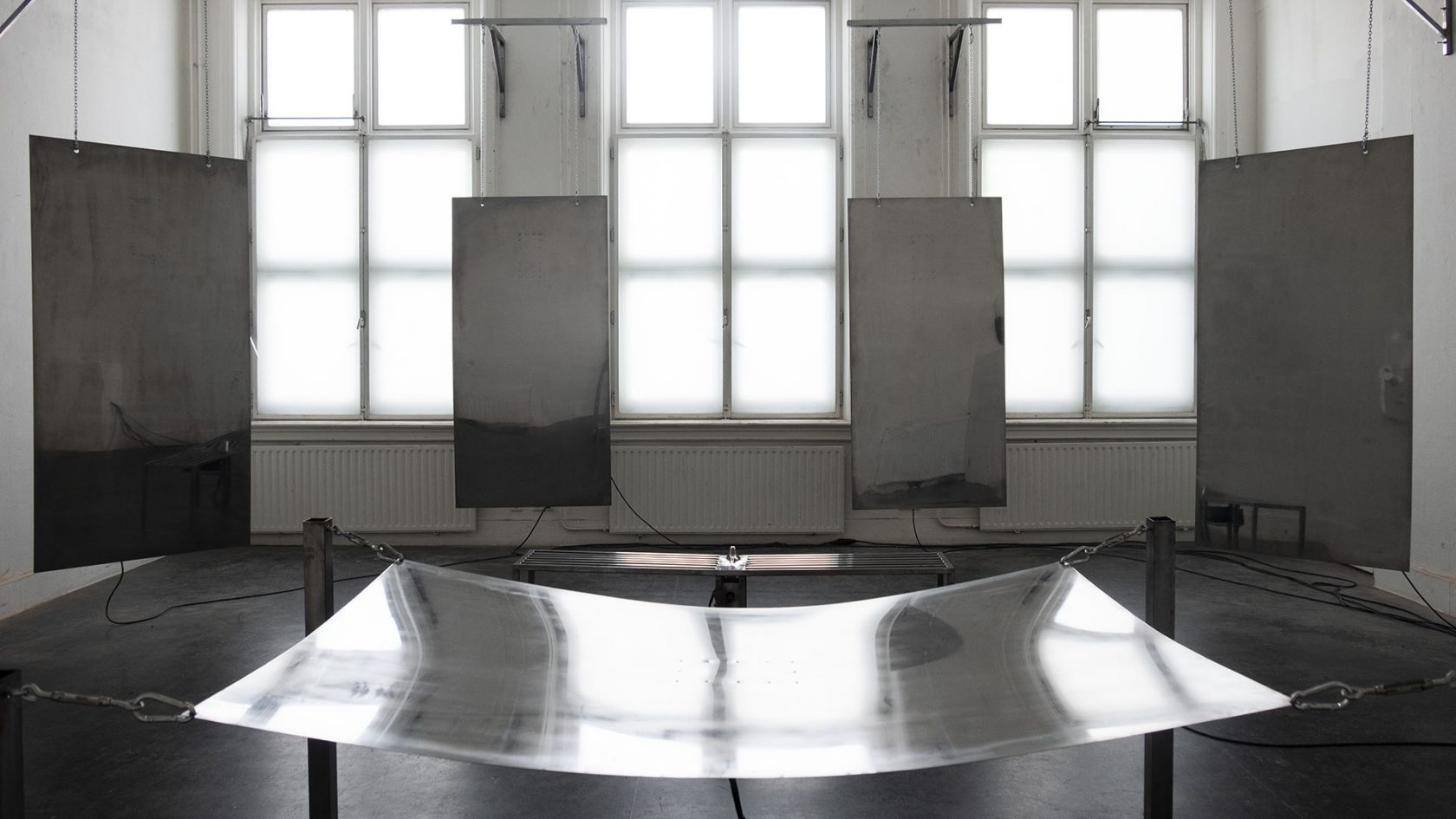
You use the term Nada Nuevo ’album’ to hold the various installations together?
Yes, that is part of the multilayered concept of the work. One of the layers is to mix the preconceptions on the notion of what music and art is. In artscience you work in between these two worlds of music and visual arts in an academic situation between the conservatory and art academy. With Nada Nuevo I wanted to make a work that would appeal to both perspectives. So I also deliberately polish the work as a visual object that I have made. I want to show the hours I spend to create it, which is more a visual arts point of view. From the musical perspective, I wanted to use the unbalanced motors as an instrument but not to focus on the resonance and to make a piece based on that. I try to put a narrative into it like I would do as a composer. I wanted to make a story that also interacts with the fact that there is a visual reflection of the audience in the polished plates and use the duration of the perception. Normally sound art is more like: I make a machine and that produces this! But the experience of the audience is much more important to me.

How would you describe the difference in attitude between the conservatory and the art academy?
It is the approach of what people had to do to come to where they are at that point. At the conservatory you probably had a more strict education which has shaped you in a certain way. You might be more critical to certain things because of the knowledge that you already have. Which is not negative nor positive. In art academy people are more open and make use of the ignorance that that possess.
Maybe from a conservatory point of view, people would have more problems to see your motorized tuba as a serious instrument?
Of course. Unless I tune it correctly! I am playing with the physical properties of the tuba itself. But instead of the lips vibrating I use an activator which is automated. I am tuning it my own way playing with the pressure and the length of the pipes.
How did music or sound start to be a part of your life?
I have always been involved in music. I played the guitar, but not very seriously. I was into the hardcore metal punk scene in Spain in my teenage years. But I was there as a photographer. I couldn’t see myself play in a band. I was used to taking pictures of my surroundings all the time. I did it riding my BMX bike and hanging out with my friends. One of my biggest inspirations at the time was the Spanish photographer Alberto Garcia-Alix.
I really learned about music and listening only four years ago when I started at the KABK. The interesting music started with artscience although my original plan was to learn programming here. I wanted to learn more technical things next to my earlier art education, also to satisfy my family’s expectations. I learned electronics and programming from zero. And in the mean time I learned to play live music and joined a crazy noise band. But I don’t consider myself a sound artist or musician.

When did the notion of art first appeared then?
There wasn’t any artistic background within my family. In Madrid I went to an American school where I got my first art classes. I followed the photography course so that was the only art I saw, apart from visiting the Louvre with my mother many many times, when we were living in Paris. At one point during my study in Madrid there was a guest talk by Daniel Canogar, who was a photographer. But he extended his photography practice with different technologies and he made huge installations out of that. He inspired me to jump over to other fields of art. Later I found out that he also worked together with the director of artscience here in The Hague, but at that time I didn’t know that. I didn’t want to be limited by photography anymore. I also had some problems with the culture of the photography world.
And now you are in The Hague.
Yes, and I intend to stay here. It is a great environment to make art. The Hague is amazing for its opportunities for artists. Madrid is of course much larger but also very saturated. It’s hard to get things going there. It is more open here. Here you can just talk to an art gallery owner to find a space to exhibit.
Can you tell me about your relationship to the Dutch composer Dick Raaijmakers (1930-2013)?
Ha, yes. Well he is the founding father of artscience. I always used one of his quotes about the philosophy that an artist should never polish his work. And I had just decided to polish everything in my work! So I decided to emphasize this in my graduation work. But he is true of course. Because if you polish your work, the work itself doesn’t get the attention. He passed away shortly before I arrived at artscience, so it is a pity we have never met.

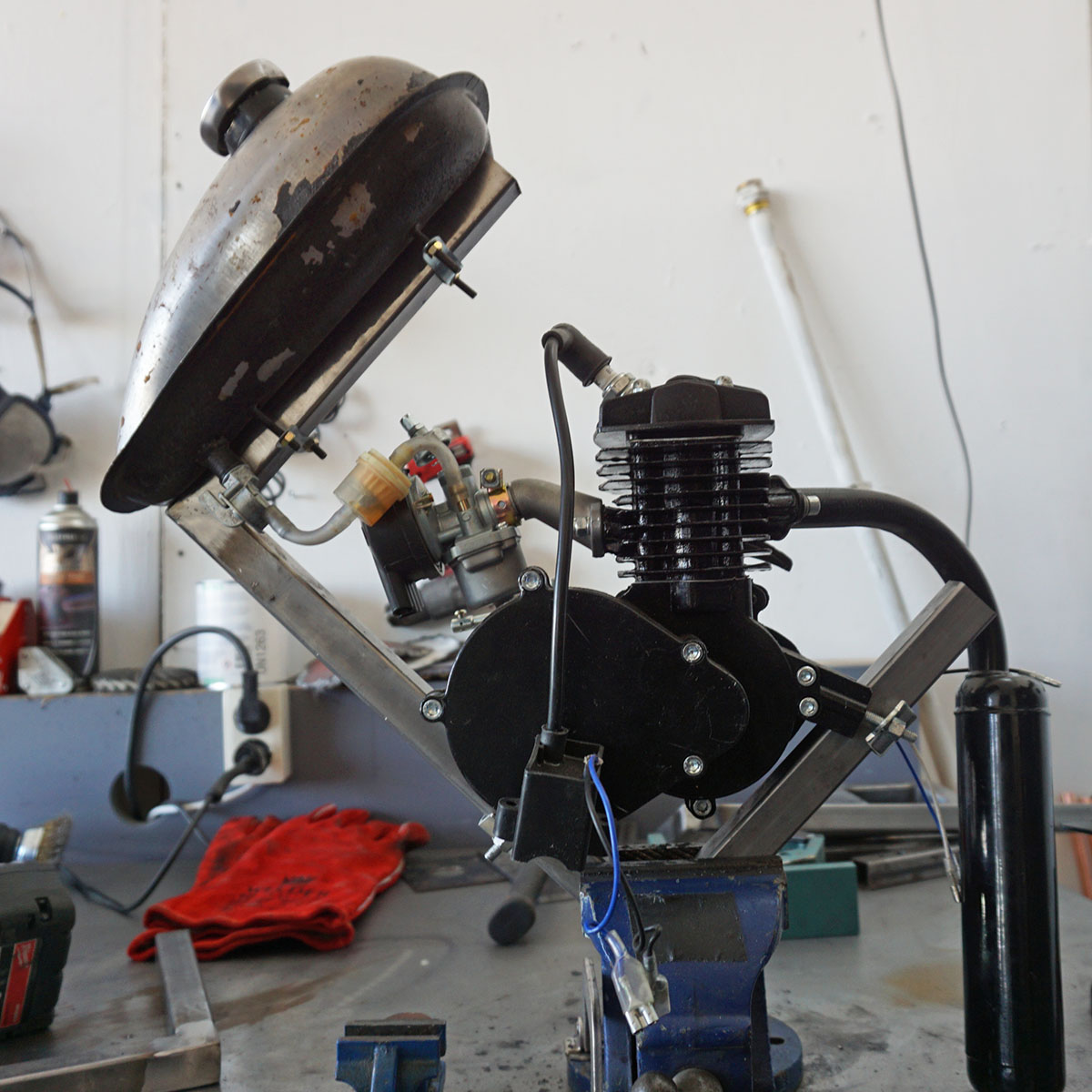
You describe yourself as a ‘non trained musician’ now. Is that an excuse or an asset?
It’s both. A friend told me the story of John Cage who teached in New York and asked his students: who of you doesn’t know any music? Only one guy lifted his hand and Cage replied by saying: very good, then YOU don’t have to forget everything! So I believe it is an asset. But it is also inaccurate. I don’t know about scales or musical notation and things like that. I can only play what feels good to me and I assume it then must also be good for others. I like the inaccuracy and the energy but also to avoid all these preconceived notions on what is good or bad music. For me it enables me to explore more things by myself.
You also have a preference for unbalanced motions in your physical works.
I like the tension it creates. I don’t call it unbalance, but maybe more ‘misuse’. I like to use the things not the way you are supposed to. With these stepper motors for example, unbalance is what you normally absolutely don’t want. But I try to emphasize this to make it vibrate even more, because I want to release the musical properties of the motors. That is what I want from them.
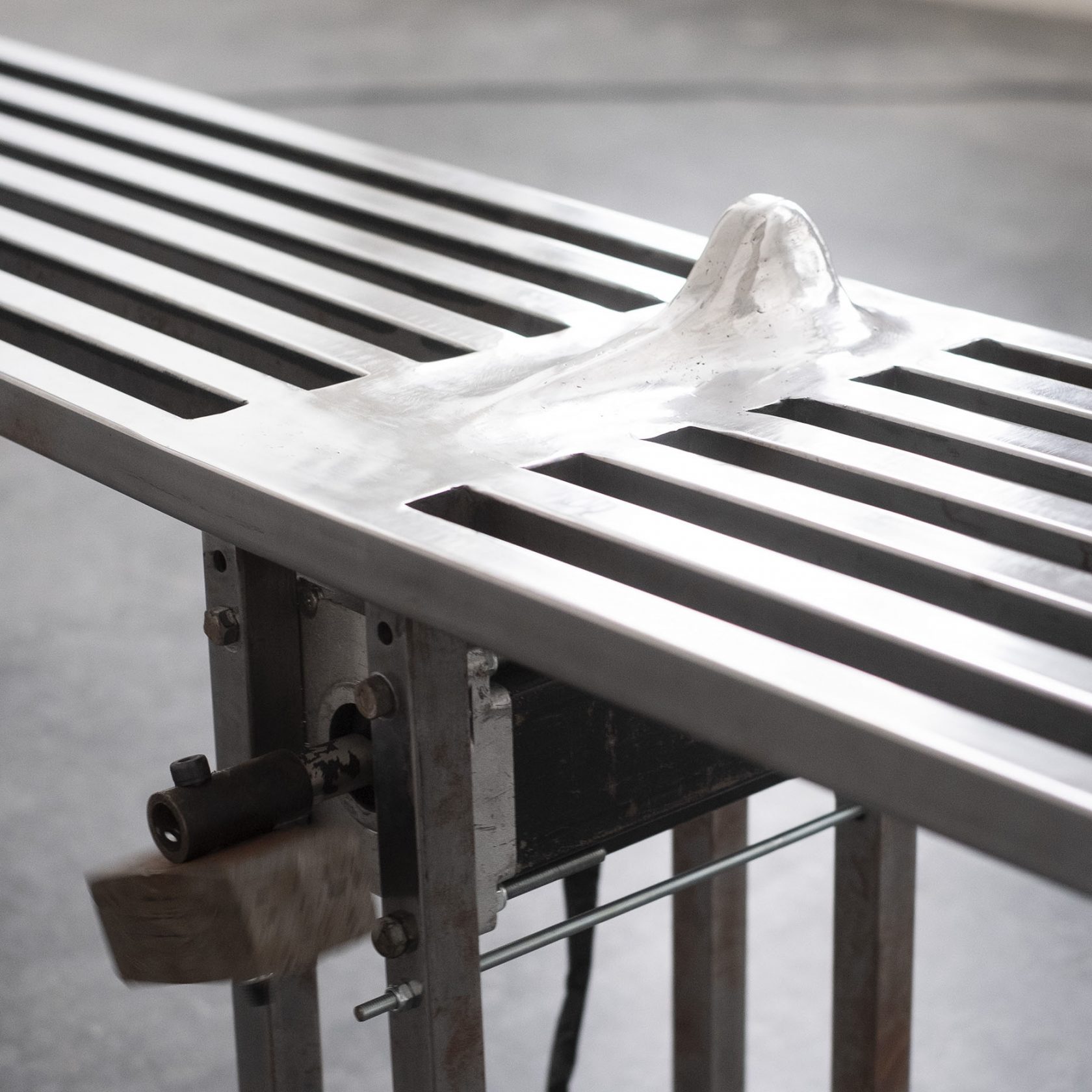

And you also like to manipulate your audience?
Yes, how the audience uses the work is how they experience it. I like to please the audience. I make art for people and I want them to enjoy it. For example with the vibrating bench this is very important. Even the inter-interaction between the people in the space is important to me. For example at Highlight Delft it was great to have people organized in groups within the hall were the installation took place.
What struck me was that people who were sitting on the bench made room after a while for somebody else to experience it.
Exactly! That was perfect. Especially the awkwardness of it. A lot of women had a special sensation sitting on the bench and you could see them thinking. Should I stay sitting here or leave?
Can I define your work as a ‘mental sensory long durational exercise’?
Ha, ha. Yes! An exercise. Yes, I like this description.
I was also having a discussion on my new work and that I have two different works with different styles meaning different things and that I should not combine them. The two motors rotating and the motor tuba are two works that should be displayed separately. So my response is: why? Even when it are two works, the presentation is a performance with both of the works put together. I think this will go well together. With every work you make, you get these biases that you can play with. Why is it incorrect to make this conscious decision that takes me extra work. It is not because I don’t have time left or anything. Preconceived notions. Why?
You also explore different body parts as receptors for example with the vibrating bench.
Yes, I am focusing on sound as a vibration. So I thought, why not feel it with your butt? And I add the pleasure quality to the work. Also with the shapes on the bench. I like to put ideas together. It’s like fusing all the layers together in the oven. But I am getting romantic now. Ha, ha!
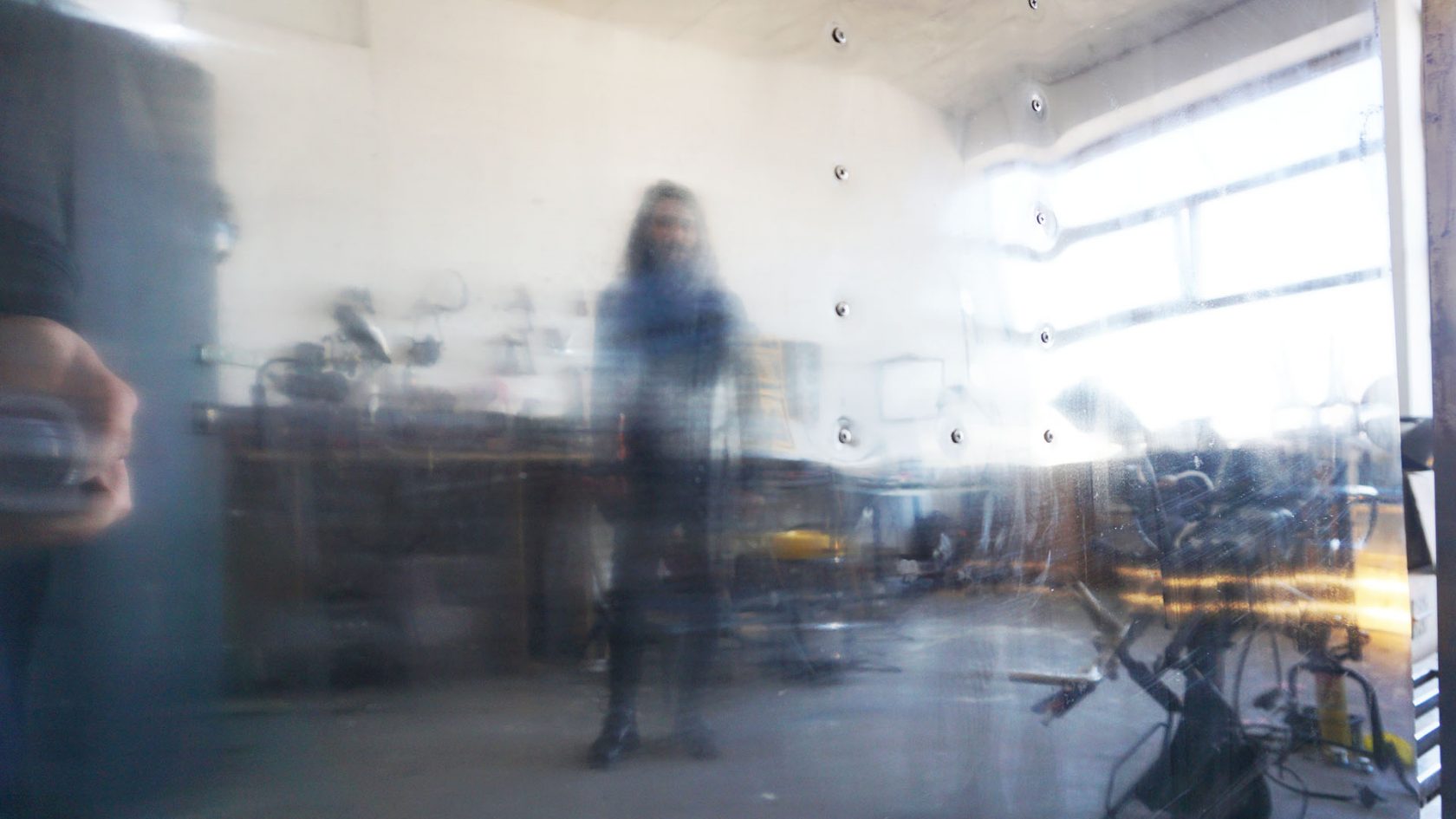
I read you belief that decision making in an artwork is detrimental to its meaning value. Can you explain what you mean by that?
Yes, every choice you make to make an artwork has a value in the final meaning of the work. For example: why do I polish the work? Because I want to add the value of polishing to the work. The time spend doing this adds to its value and visual properties.
Or the question: Why is it automated? Why don’t I play it myself? That would be way easier. That is because I want to focus on the sound of the object and not have a person being around. And this is something that I can do nowadays. Twenty years ago I would need a lot of knowledge to achieve this for a person like me, but now it can be done.
What is the ideal presentation space for your work?
That depends on the work, totally. This new work was meant to be presented in a theatre setting, because it was planned for the Rewire festival. It is strange that I am now not able to present it with people. But I prepare it as planned. It is a challenge now how it will work out. All these explosions coming out of this tube. You have to feel that. Now it only exists because it will be documented in an internet setting. But it is a nice challenge and I am grateful for iii, for their support and the importance of their job right now. All stages of the process and the sources I used are now becoming part of an online archive of documentation.
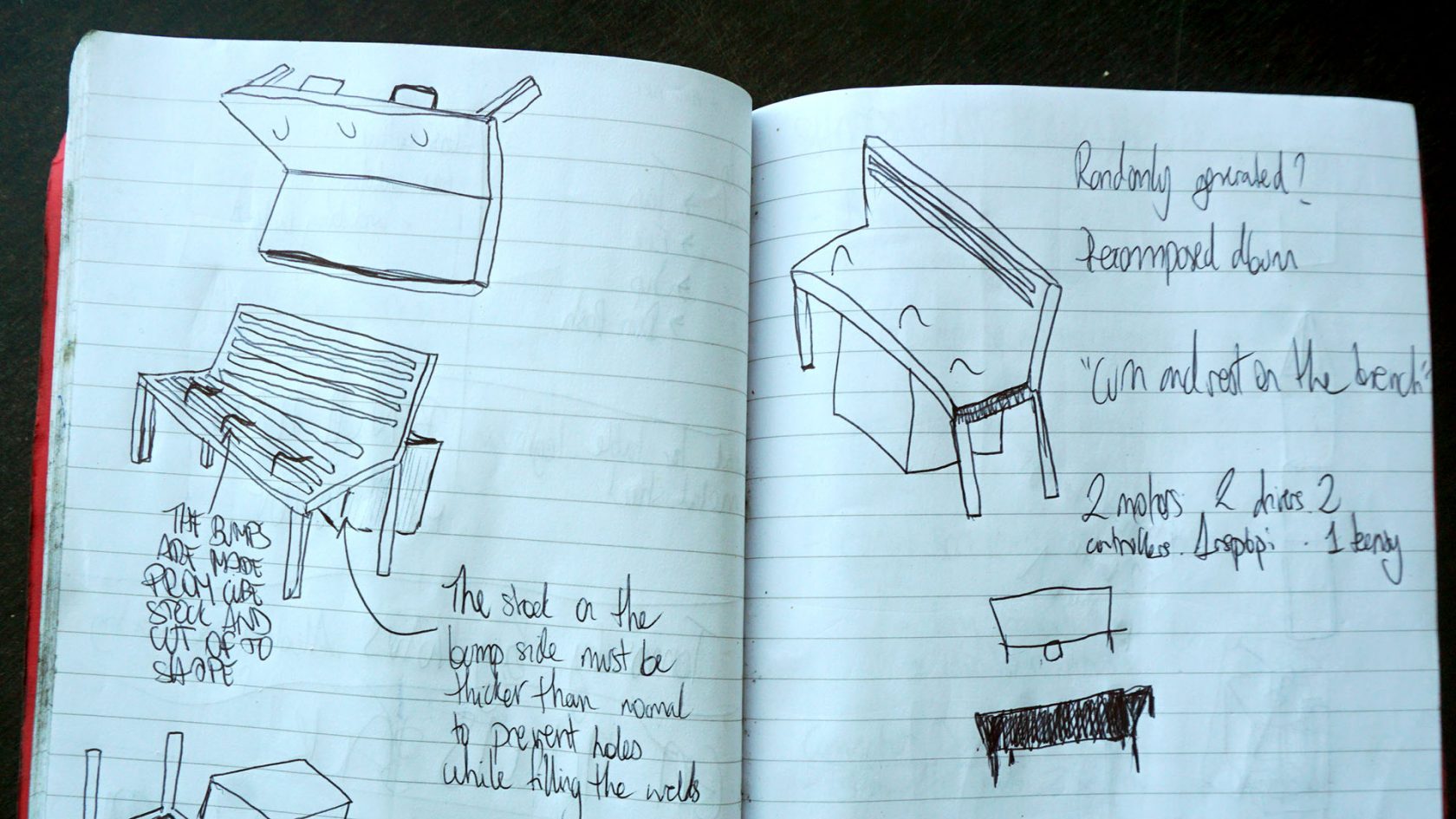
How do your projects start?
I have a clear picture of what I am trying to achieve. Just like a photograph. But during the process I am open to adjustments. And then one thing leads to another.
I don’t see any sketches, drawings or notes here on your studio walls.
I have it all here in my little sketch books. I use the studio mainly to work on the materials. Welding, cutting, fixing things. Normally the tables are full of electronic instruments and stuff.
To show the process from the iii residency, I want to share all the YouTube videos that I used for this work. Movies on motors, polishing, tubas, troubleshooting. The algorithm of YouTube has a great influence on my art.
You work individually mainly?
I have collaborated in projects, but yes, I am a lonely worker and I enjoy the discovery process of learning all the things that I see. However, I do know the value of joining minds, and the strengths that collaborating may offer in our times were individualism is almost demode is unprecedented. I am currently working on collaborations with Brigitte Louter and Gokay Atabek. At the same time, I like to be involved in every aspect of my work and at least know how it works. I cannot manufacture an engine myself, but I do know how it works and how to manipulate it to work the way I want it to work. Once you learn about all the different aspects, you can use that as a meaning conveyor for the audience too. It helps you to make decisions on what you want to achieve.
At school I was a pretty good student. But I decided to make ‘art’, in which I didn’t see anything useful at the time. It hurts me that I could have been a good programmer or do other things. I have always had this ambition to gain knowledge. I wanted to be good at math or microphysics.
Why does that hurt? Is it because you wanted to live up to the expectations of your family?
I think so. Within my background ‘art’ meant nothing. It was not a goal in someone’s life. But at the same time my family have always supported me.
Are they able to follow you in your art?
Yes, they do. They have never stopped supporting me and we are still close. My grandfather for example has always worked for a big company. And when he retired, he started doing the things that HE wanted to do. He learned to play the piano, which he now does very well. He studied math and now writes and translates books on math. For me as a child seeing an old person learning so much really inspired me. There is no limit in what you can learn.
Maybe what you learned is that your grandfather had to serve others first and that you could take this step earlier in your life?
Yes. Talking with my grandfather about this he said: So, you are basically doing what you like and try to live from what you do? And that is true. It is a most privileged position that I have.
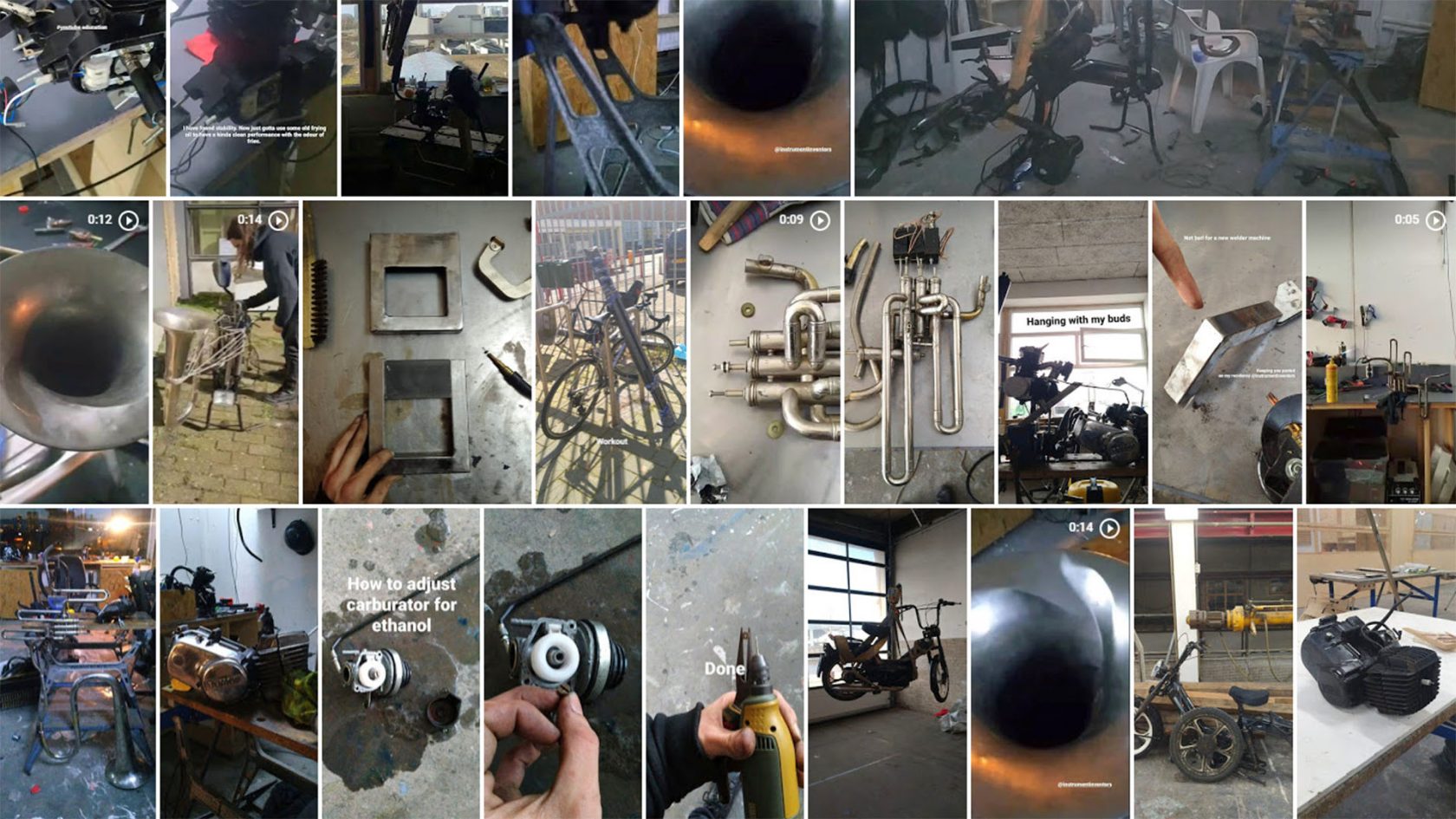
Jesus Canuto Iglesias will perform at iii workspace in The Hague on April 4. The event will be documented.
The planned original public event No Patent Pending #39 with Jesus Canuto Iglesias, Pelle Schilling, Gabriela-Prochazka, and Joana Chicau is postponed until further notice. Check out the website for the latest info.